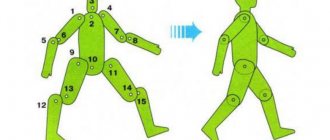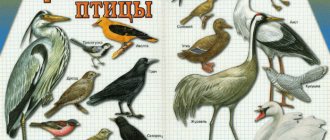Summary of educational activities for the development of speech “City - Village”
Summary of educational activities for the development of speech “City - Village”
Jerina I.B.
Summary of educational activities for the development of speech “City - Village”
Content of organized educational activities.
Goals: to give children an idea of what a city and a village
, What is the difference;
give children knowledge about the peculiarities of work in the city and village
. To instill in children a feeling of love for their Motherland - Russia.
Develop memory in children
, logical thinking, visual attention and perception.
Strengthen children's coherent speech
, formation of the grammatical structure
of speech
,
developing the sound culture of speech
, enriching vocabulary.
Developmental environment
: paintings depicting rural and
urban landscapes
;
handout subject pictures depicting objects related to the city and village
(multi-story building, buses, trolleybuses, underground passage, one-story houses, combine harvester, tractor, pets, etc.). Simple pencils, notebooks for graphic writing in large squares.
Organizing time.
The teacher invites the children to look at two paintings depicting an urban and rural landscape
.
Questions for children: 1. What do you see in the paintings? 2. Which picture shows the city
?
3. Which picture shows a village or a village
?
4. Do you think we live in a city or a village
? 5. Why did you decide this? 6. Which of you was in the village? Tell us what kind of houses there were in your village. What was the transport like? Children's answers.
Didactic game “Say it differently”
. Goal: to teach children to form adjectives from nouns. Progress of the game: children must say the phrase spoken by the teacher differently.
Lexical material.
Man living in the city
, (what...
( urban )
.
A person living in a village (what... (village)
.
Village resident (what... (rural)
.
Post office located in the village (what... (village office)
.
Shop in the village (what... (rural)
.
Didactic game “And here, in the village”
.
Goal: to teach children to form words using diminutive suffixes - k -, - chk -, - enk -, - ok -, - ik -. Progress of the game: the children are offered a short story: “A grandmother came to visit us from the village. She walked around the big city and was amazed at
big the houses
are in our .” The teacher invites the children to say the words spoken to them affectionately, as the kind grandmother calls them.
Lexical material.
A village is a village.
Street - street.
City - town
.
Prospect - prospectus.
A house is a house.
Didactic game “Finish the phrase”
. Goal: to teach children to form masculine, feminine, neuter singular and plural nouns in the genitive case. Progress of the game: the teacher invites the children to finish the phrase he started:
Grandma has one square in the village, but in the city there are many... (squares)
.
Grandmother has one street in the village, but in the city there are many... (streets)
.
My grandmother has one church in the village, but in the city there are many... (churches)
.
Grandmother has one store in the village, and in the city there are many ... (shops)
.
My grandmother has one museum in the village, but in the city there are many... (museums)
.
The teacher tells the children about what is happening in the city
, and people work in the village.
The teacher draws the children's attention to the pictures and invites the children to tell where people work - in the city or the village
?
(In one picture, cows are being milked, and in the other, workers are standing at the machines)
. Children's answers.
The teacher continues his story; “ There are many factories in the city
, factories where people make cars, books, toys and much more.
There are enterprises
in where they make cheese, cottage cheese, kefir, sour cream, yogurt, and butter.
All this is made from milk. Where do they get milk? That's right, in the village, in the village. There people raise livestock, milk cows, and bring milk to the city
, and you and I can buy products made from milk in the store.
There are many factories in
where bread is baked. Where do they get flour for bread? Yes, in the village they grow wheat and rye, from which they then make flour.
In the village, they grow vegetables in the fields, and in the gardens they grow very healthy and tasty fruits, which we love very much and often buy in stores in the city.
.
But to grow and harvest crops, you need different equipment - tractors, combines.
Where will rural workers get them from? That's right, all the equipment is made by workers in the city
.
This is how city and village
.
(The teacher accompanies his entire story by showing illustrations)
.
Dynamic pause. Finger exercise “House and gates”
.
There is a house in a clearing ( "House"
draw with two hands, the roof of a house - the fingers of the left and right hands touch each other).
Well, the path to the house is closed. (The right and left hands are turned with palms facing each other, the middle fingers touch each other, the thumbs point up ( “gate”
).
We open the gates, (Palms turn parallel to each other)
.
We invite you to this house. ( "House"
).
Didactic game " City - Village "
.
Children place on the board under the large picture - small ones on which the image relates to the city and explain
why they think so. Then the children find pictures related to the village.
Graphic letter “Complete the house according to the model”
.
In large-checked notebooks, children draw a village one-story house and a city multi-story house
.
Reflection.
The lesson is summarized. Children talk about how people in our country live in cities
, villages, hamlets.
The city
has many streets with multi-storey buildings, a lot of different types of transport, people work in factories and factories.
In villages and villages there are few streets, the houses are not multi-story, and there is little transport. People grow wheat, rye, various vegetables, fruits, and care for various domestic animals. People in the city
and villages help each other.
The teacher gives the children a task: to learn their home address with their parents. See what new and good things have appeared near their house for the convenience of people (they paved the paths, painted the buildings in the yard, planted trees, repaired the entrance, etc.).
Abstract of the NOD for the NGO "Cognitive Development" "Travel to the Native Village"
Is it good in your native land? (spread their arms to the sides) Okay! (thumbs up)
Motivation and goal setting
.
V.: Guys, I didn’t come to work at the kindergarten today alone, the girls Masha and Dasha came with me. Let's say hello to them. These are the granddaughters of my neighbor, an old grandmother. They came from the Tula region to visit their grandmother, but they were bored sitting at home, and their grandmother asked me to take a walk with the girls and introduce them to the village. But I, guys, have very little free time, and I decided to take them with me to work, maybe we can figure out together how to entertain Masha and Dasha.
Conversation:
— Guys, what can you offer? (Answers)
— How can we introduce them to our village? (Answers)
- How can we go on an excursion? (Answers)
The children suggest going on a trip by bus.
Main part.
V.: Guys, to travel by bus we need a driver and we need tickets. The driver will be the one who is the first to correctly say the name of the village in which we live, and what we, the residents, are called.
Q: To get tickets, you need to give your home address. Whoever names the street gets a ticket. At the same time, we will tell our guests about what streets there are in our village.
Word game with a ball “Name the street”
Children take turns unwinding a ball, on the threads of which tickets are glued (photos of the village). They give their home address, take a ticket and go to their seats.
Everyone sits down on chairs, the music “We are going, we are going, we are going” is playing in the background.
V.: Our village of Znamenskoye is our small Motherland, the place where we were born and live. During the excursion we will make stops at various interesting places in our village. Look ahead, I can already see a familiar building. Let's stop and see what it is.
On the easel is a photograph of the museum building.
V.: What is this? (Answers)
— Do you like going to the museum? (Answers)
V.: Yes, you guys are right, the museum has already become a favorite place for us, we often go there for various museum classes. The museum has many halls, but we will visit the Animal World exhibition. Do you know the forest animals of our region? I suggest playing the game “Name the extra animal.”
Didactic game “Name the extra animal”
There are pictures of animals on the easel; you need to name and remove the extra ones that do not live in our area, and explain your choice.
V.: And now I suggest you take a little walk, get some fresh air.
The children are walking, and on the projector screen the children see a photograph of the district park.
Q: Guys, pay attention to where we have come? (Answers)
Would you like to take a walk around the park, listen to the voices of the birds and tell Masha and Dasha what trees grow in our area?




